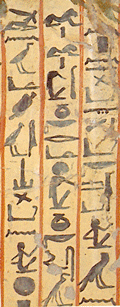
Usually right to left
Scribes usually wrote hieroglyphic from right to left, but within columns. On temple walls and papyrus writing was mainly in columns, which you read down (see the example here). But when two hieroglyphs are next to each other, you go right to left. (that's this way: <----). And you start at the right of the wall or the page and go left, from column to column.
This is the opposite to English; you are now reading from left to right, right? Most European languages go left to right, like English. But some other languages, like Arabic and Hebrew, go right to left, like Egyptian.
But also left to right!
Scribes were also allowed to write left to write, like we do.
Huh? So how do you know which way to read hieroglyphs?
There's an easy way to tell which way hieroglyphs should be read.
Look at the faces!
All you have to do is look at which way all the faces are pointing. Then read towards the faces.




